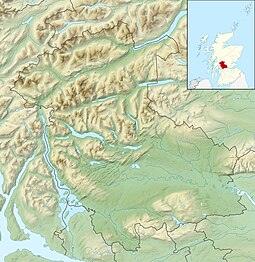Inchcailloch
| Gaelic name | Innis na Cailleach |
|---|---|
| Meaning of name | Isle of the old woman |
| Location | |
| OS grid reference | NS410905 |
| Coordinates | 56°04′52″N 4°33′18″W / 56.081°N 4.555°W |
| Physical geography | |
| Island group | Loch Lomond |
| Area | 50 hectares (0.19 sq mi) |
| Area rank | 199= (Freshwater: 6) |
| Highest elevation | 85 metres (279 ft) |
| Administration | |
| Sovereign state | United Kingdom |
| Country | Scotland |
| Council area | Stirling |
| References | |
Inchcailloch (Scottish Gaelic: Innis na Cailleach) is an island on Loch Lomond in Scotland. It is 85 m at its highest point. It is also known to some as Inchebroida.
The name Inchcailloch means "Isle of the old woman" or "Isle of the Cowled Woman" in the Scottish Gaelic language. Saint Kentigerna went to Scotland from Ireland to preach and spread Christianity and the island is thought to be named after her.
Inchmurrin, Creinch, Torrinch, and Inchcailloch all form part of the Highland boundary fault.
There is a burial ground in the north of the island, and a bay, Port Bawn (Scottish Gaelic: Port Bàn; English: White Port), in the south.
Like many of the Loch Lomond islands, it is quite heavily wooded.
There is a passenger ferry across the short channel separating it from Balmaha on the mainland. As a result, it receives more visitors than most of the Loch Lomond islands, currently 20,000 visitors per year. There is a camp site in the south at Port Bawn and a nature trail.
Inchcailloch has been used as a hunting forest since the reign of Robert the Bruce. Deer still roam the island. White deer have been seen on the island in 2003. The narrow crossing is very shallow making an easy passage for deer to ford. The island was farmed until the early 19th century, being recorded in 1800 as producing good wheat and oats; the ruins of the farm can still be seen. For around 130 years, Inchcailloch was an oak plantation. The resulting timber was processed at Balmaha (on the site of the Highland Way Inn), for making wood vinegar (pyroligneous acid), wood tar, and dye.
Inchcailloch had a church dedicated to St Kentigerna, which was the parish church until 1621, but the graveyard was used until 1947. St Kentigerna was an Irish woman who is not to be confused with St Kentigern (a man who is also known as St Mungo). The Clan MacGregor burial ground includes some of Rob Roy's ancestors. Legends have passed by word of mouth that the bones of a woman were found under the altar stone during an excavation.
...
Wikipedia

